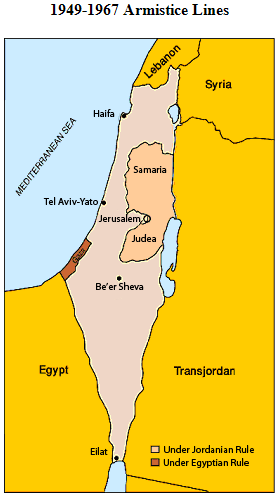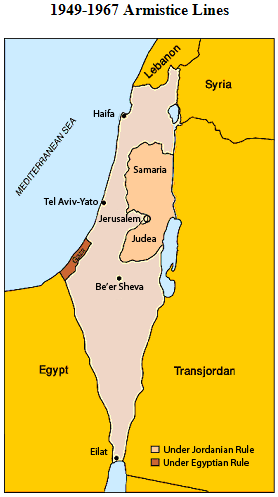Causes, course and consequences of the war of 1967
The Suez Crisis 1956
Between 1965 and 1967 Syria, with the aid of Russian advisers and military supplies, bombarded Israeli settlements in Galilee from gun emplacements on the Golan Heights. This culminated in a major air battle between Israeli and Syrian fighter planes on 7th April 1967.
On 15 May 1967 Egypt demanded the withdrawal of the United Nations Emergency Force (UNEF) in Sinai. U Thant, Secretary-General of the UN, agreed, and the UN troops were immediately withdrawn without the approval of the United Nations General Assembly.
Egypt advanced a massive armoured force, including 900 tanks, into the Sinai. Syria assembled a force of more than 400 tanks on the Golan Heights. Jordan’s King Hussein flew to Cairo to sinn a defence pact with and placed Jordan’s troops under a unified command with the Egyptians. Iraq also signed the pact and declared that it would join “the final battle”. In all the Arab forces deployed some 1600 tanks and had some 700 combat-ready aircraft, as against Israel’s 800 tanks and 300 aircraft.
On 23 May Egypt closed the Straits of Tiran in defiance of the guarantees given by the “maritime Powers” in 1956. In effect this operated as a blockade against all Israel shipping to the East, including Australia. For the next two weeks Israel’s Foreign Minister Abba Eban travelled the world, seeking without success to enforce the guarantees which had been given as a condition of Israel’s withdrawal from Suez and Gaza.
President Gamal Abdel-Nasser of Egypt made speeches comparing the coming destruction of Israel to the defeat of the Crusaders by Saladin. On 25 May 1967, Nasser made an announcement to the Egyptian Parliament:
“The problem before the Arab countries is not whether the port of Eilat should be blockaded or how to blockade it – but how totally to exterminate the state of Israel for all time.”
Syrian Defence Minister Hafez Al-Assad (later President):
“The Syrian army, with its finger on the trigger, is united. I believe that the time has come to begin a battle of annihilation.”
PLO Chairman Ahmed Shukhairy:
“Those [Israelis] who survive will remain in Palestine. I estimate that none of them will survive”
The Events of 1967

In a surprise attack on 5th June 1967 the Israeli air force destroyed the bulk of the Egyptian air force on the ground.
Israeli armoured forces then destroyed the Egyptian tanks in the Sinai, and took Gaza and the greater part of the Sinai in two days.
Jordan rejected Israel’s offer of non-belligerence, conveyed by General Odd Bull, the Norwegian Chief of Staff of the United Nations Truce Supervision Organization, and Jordanian forces shelled Jerusalem and the northern suburbs of Tel Aviv. In heavy fighting, Israeli forces succeeded in taking East Jerusalem, including the Old City and the Temple Mount. This was followed by the rest of the West Bank.
At midnight on 8th June a cease-fire came into effect between Israel, Jordan and Egypt.
Meanwhile there was a fierce battle as Israeli tanks climbed the Golan Heights under Syrian fire. The Heights were taken by Israel on 10th June, and the war ended with the call for a ceasefire by the UN.
Immediate Consequences

Israeli soldiers arrive at the Western Wall of the Temple in Jerusalem
Israel came into possession of the Sinai desert up to the Suez Canal, the Gaza Strip, the West Bank, East Jerusalem including the Old City, and the Golan Heights.
Israel announced an official policy of “territories for peace” i.e. withdrawal to secure borders to be negotiated, in exchange for “full peace” and recognition.
CEASEFIRE LINES 1967

CEASEFIRE LINES 1967

Source: Website of the Israel Ministry of Foreign Affairs
Note: The Sinai was returned to Egypt in 1982 under the 1979 Peace treaty. Gaza and the West Bank are under the jurisdiction of the Palestinian self-governing authority, with the position of those borders to be determined by negotiation. Note the position of the Suez Canal and the Straits of Tiran, governing access to the Red Sea.
The Arab response came from the thirteen-nation Arab Summit Conference held at Khartoum. On 1 September1967 the Conference made a declaration, which came to be known as the “Three No’s of Khartoum” – “No peace with Israel, no recognition of Israel, no negotiations with it, and insistence on the rights of the Palestinian people in their own country.” (See The Khartoum Resolutions 1967 for full text)
Resolution 242
On 22nd November 1967 the Security Council of the United Nations adopted a resolution, sponsored by Britain, which remains one of the central documents of the Middle East conflict.
The resolution included the following elements:
– Withdrawal of Israel “from territories occupied in the recent conflict”;
– The right of “every State in the area” to live in peace within “secure and recognized boundaries”;
– Guarantees for freedom of navigation in the Suez Canal and through the Straits of Tiran;
– “Just settlement of the refugee problem”.
The resolution was accepted by Jordan and Egypt on the basis that “territories” meant “all the territories”, and that any settlement should be “subject to the right of the Palestinians to continue their struggle for the liberation of the whole of Palestine”.
The resolution was accepted by Israel (despite misgivings at the fact that the word “Israel” was absent) on the basis that the word “territories” was limited to be read as subject to Israel’s need for “secure” boundaries.
It was rejected by Syria and the PLO, who called for the “liberation of Palestine” by force. (See UN Resolution 242 for full text)
1968-70 The War of Attrition
After the Six-day War Egypt embarked on a policy of bombardment of Israeli bases in Sinai. Also the Soviet Union supplied Egypt with missiles and “advisers” including Soviet pilots.
Intensive diplomatic activity involving the United Nations, the USA and the USSR ended in a UN sponsored cease-fire in August 1970, which was quickly broken.
However, after the death of Nasser on 28th September 1970 and the accession of Anwar Sadat, the tension gradually abated.
